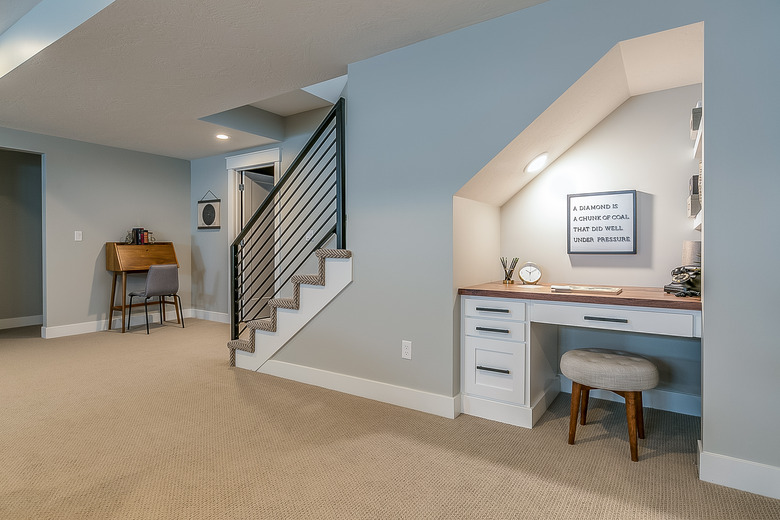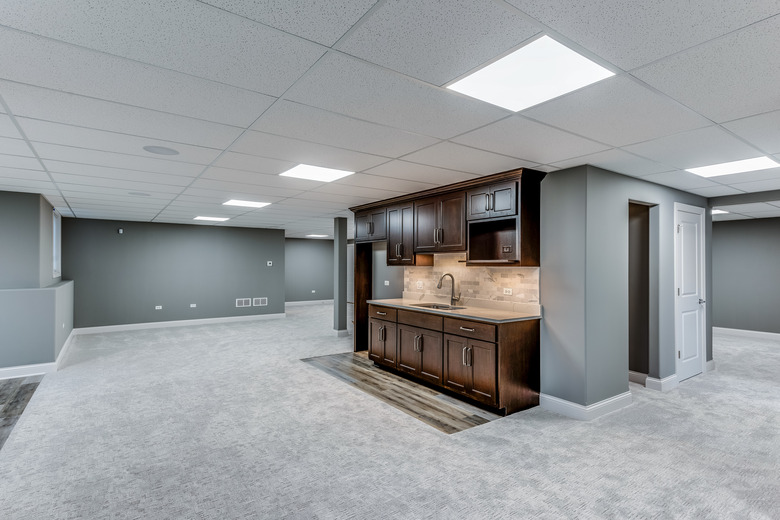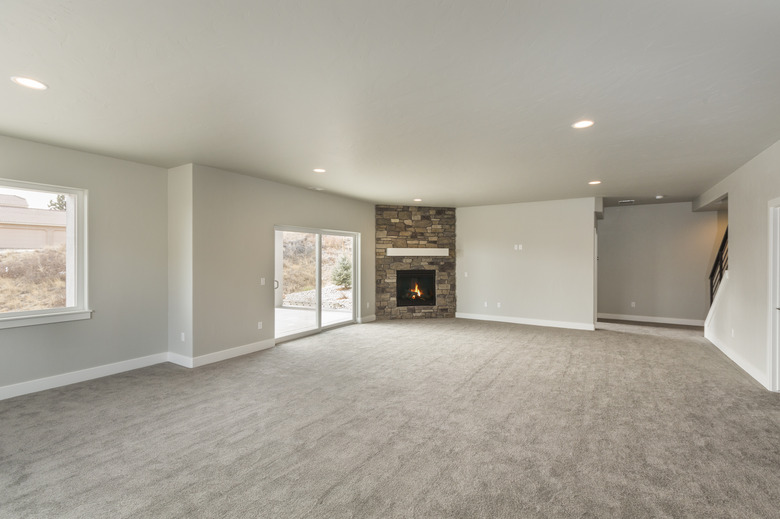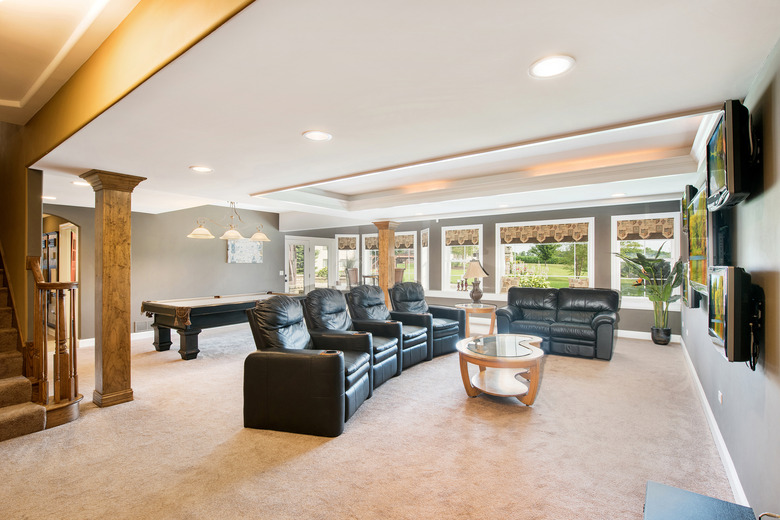The Best Carpet For Basements: Which Material Is Right For You?
We may receive a commission on purchases made from links.
Although everyone can agree that the basement floor is no place for a prized Persian rug, there are still plenty of options to cover your bare concrete — including warm, fluffy carpeting (perfect for those sometimes-chilly subterranean temperatures). But, before you go to your nearest flooring store, there are a few things to keep in mind before you select your carpeting. Most importantly, you should focus on a carpet fiber's ability to resist moisture.
A finished basement, even one that is well insulated, is simply too damp for natural fibers, including wool, sisal, jute, or cotton. The main problem isn't moisture in the air — although that can definitely be an issue — but moisture that seeps through the basement subfloor.
Because it's situated below grade, a basement floor may be close to the water table and may even be in contact with it. Groundwater exerts hydrostatic pressure against basement surfaces that can push moisture through a porous concrete slab, which is the material of most basement subfloors. When basement floors sweat, the moisture gets trapped underneath any carpeting you've placed there, promoting mold growth and deteriorating carpet fibers.
Want to install carpeting in your basement, but unsure of what to look for? Here's what you need to know.
Best Basement Carpeting Options
Best Basement Carpeting Options
In order to survive in your basement, your carpeting has to have two qualities: It should resist deterioration, and it should allow the basement floor to breathe. Natural fibers can't do either, but synthetic materials can do both, which is why they are most often recommended for basement installations. There are four common options:
Polyester
Polyester comes in bright colors and has great resistance to staining from non-oily substances. When it's manufactured from recycled bottle caps and tires, it is considered a green carpeting material. Sometimes available for a mere $1 per square foot, polyester is also one of the least expensive carpeting materials out there. Oily spills tend to stick to the synthetic fibers and attract dirt, however, but the main reason polyester isn't more popular is that it mats down quickly, and in a high-traffic area, it might look completely worn after only five years.
Nylon
One step up from polyester and one of the most popular carpet options, nylon is more durable, but it's also more expensive. It has great stain resistance and is easy to maintain, usually needing just the occasional vacuuming to stay clean. If you are able to keep basement humidity low enough to make steam cleaning practical, you're in luck because steam actually revives the synthetic fibers in a nylon carpet. On the downside, nylon isn't as soft as other materials, and it generates a lot of static electricity.
Olefin
Olefin is a polypropylene material that's spun from plastic pellets, and it can also be made from recycled materials. It looks and feels like wool, but it's waterproof, mold- and stain-resistant, and costs about as much as polyester — sometimes less. The color is "baked into" the fabric during manufacture and won't fade. Olefin isn't as resilient as other carpet materials; it wears quickly in high-traffic areas, and the woollike carpet fibers catch and tear easily on furniture when it's moved around the room.
Triexta
Introduced by Mohawk in 2009, SmartStrand carpet is made from a triexta, a polymer engineered by Dupont, the same company that developed nylon. About 37 percent of the raw materials are derived from corn sugar, so it contains fewer petrochemicals than other synthetic carpets. Being a relative newcomer to the market, triexta is somewhat untried in terms of wearability, but on the plus side, it's soft, mold- and stain-resistant, and only moderately expensive, costing between $2.29 and $4.48 per square foot. Its main drawback is that like microfibers, the fibers electrostatically attract dirt, so triexta can be hard to vacuum.
What to Look for in a Good Basement Carpet
What to Look for in a Good Basement Carpet
Many homeowners prefer carpet over other flooring options, including vinyl, engineered hardwood, and laminate flooring because carpet is soft to walk on, it insulates, and it's a forgiving material that works well on a subfloor that is in less than perfect condition. Homes and the people who live in them are different, though, so the best basement carpet for one household might not be the best choice for another. Factors to consider include:
Pile
Low-pile carpets are generally the best choice for basements. Unlike the high-pile carpet you might choose for the living room, low-pile carpet is less likely to trap moisture and needs less time to dry out if it does get wet, which is important for controlling mold and mildew. Many homeowners opt for Berber carpet, which has a closed loop, giving it a flat, textured appearance.
Waterproofing
If your basement is vulnerable to flooding and water damage, you'll need a material that can handle being submerged. Most synthetic carpet materials are completely waterproof, and some are commonly installed outdoors. If you have a water problem in the basement, you'll probably want to confine your choices to the least expensive materials, such as polyester and olefin.
Durability
If you reserve the basement for purely utilitarian purposes, such as storage, you'll want the most durable carpet, which is nylon. If the basement is a place for kids to play and grownups to relax and watch TV, you'll probably prioritize comfort over wearability, in which case the best flooring options would be olefin or triexta.
Sectioning
Wall-to-wall carpeting isn't the best idea in the basement because if any part of it sustains water damage, the whole thing has to be replaced. If you install carpet in sections, dividing it by rooms or by parts of a room, you'll only have to replace the sections that do get damaged. Carpet tiles are the best choice in this regard because they can be replaced individually, and it's a DIY job.
Carpet Padding
One way to control moisture from a concrete floor is to install an impermeable rubber pad, but some carpet experts are against this idea, instead recommending a carpet pad that allows the floor to breathe. Either way, carpet padding is important because it provides extra insulation, protects the carpeting from dampness, and provides cushioning, which you need when the subfloor is made of concrete. The best breathable carpet pads are made from open-cell synthetic foam or from synthetic fibers.
A 1/2-inch, 8-pound carpet pad at minimum is recommended for comfort. If you have pets, the pad should also have a plastic coating on the front and back to help it resist stains. Even though synthetic carpeting resists spills and pet accidents, the spills often soak through to the pad, which can be damaged if it isn't protected.
Tips for Maintaining Your Basement Carpet
Tips for Maintaining Your Basement Carpet
Like any carpeting, basement carpeting is bound to get dirty from tracked-in mud, spills, and general dirt accumulation, so it's going to require regular cleaning and maintenance. The easiest maintenance procedure is to vacuum regularly. If you have triexta carpeting, you'll need one of the soft carpet vacuum cleaners recommended by Mohawk to get it really clean. When stains occur, you can usually remove them with a steam cleaner by yourself or hire a cleaning contractor to do it.
The most important thing to remember when you have carpeting is to keep the basement as dry as possible because excess humidity will eventually damage any type of carpet, not to mention that airborne water particles often carry flecks of dirt that settle on the carpeting and make it dingy. Ways to control basement humidity and floor dampness include:
- Providing ventilation: Basements typically have at least one window, and some have several. Keeping the windows open in dry weather allows air to circulate and promotes evaporation. Opening ground-level windows in rainy weather is likely to make the basement more humid. As an alternative, keep the door to the floor above open and run a fan to circulate air out of the basement.
- Running a space heater or dehumidifier: Moisture tends to precipitate out of cool air and settle on the floor, so if the basement isn't heated, run a space heater to keep the basement warm. Keeping a dehumidifier running in the basement will also suck moisture out of the air and keep it dry. Running a dehumidifier with a fan will circulate air in corners where condensation is most prone to appear and will prevent mold and mildew from growing in the carpet.
- Controlling leaks: During the carpet installation process, you can prevent a concrete subfloor from sweating by painting it with a moisture-blocking concrete primer. If your basement has concrete or cinder block walls, you can paint them to make them more watertight. It goes without saying that plumbing leaks should be repaired promptly to prevent water damage.



